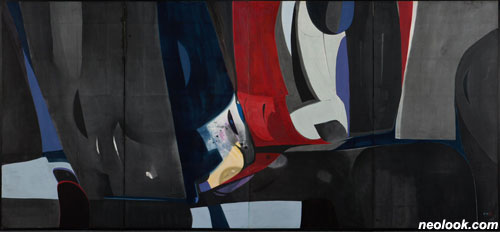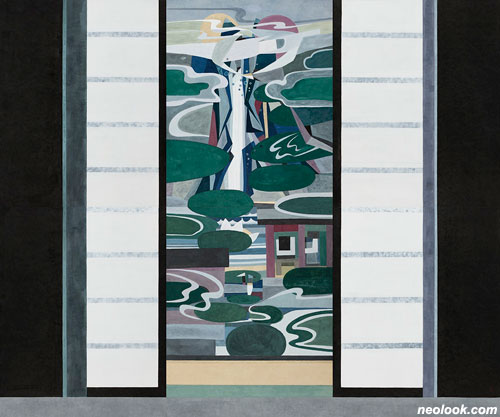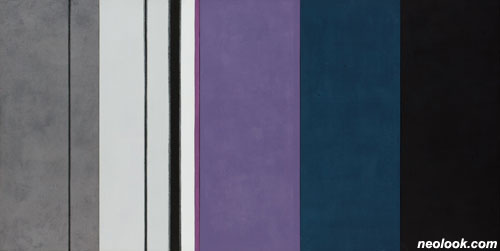- ● homepage
- ● archives
- ● restoration
- ● books
- ● big banners
- ● post board
- ■ neo's search
- ■ about us
- ■ 게재방법 안내
- 개인정보처리방침

- [email protected]
- Tel. 02_335_7922
- Fax. 02_335_7929
- 10:00am~04:30pm
- 월요일~금요일
- 3/3(월) 대체공휴일

이천시립월전미술관 2014 봄 기획전
남계 이규선展 / LEEKYUSUN / 南溪 李奎鮮 / painting 2014_0425 ▶ 2014_0629 / 월요일 휴관

- 남계 이규선_서창청공書窓淸供9_종이에 수묵담채_50×72cm_2012
초대일시 / 2014_0425_금요일_03:00pm
후원 / 이천시청
관람료 / 성인 2,000원 / 청소년 1,000원 / 어린이 600원
관람시간 / 10:00am~06:00pm / 월요일 휴관
이천시립월전미술관 WOLJEON MUSEUM OF ART ICHEON 경기도 이천시 경충대로 2709번길 185(관고동) Tel. +82.31.637.0033 www.iwoljeon.org
文人畵로서의 抽象畵-南溪 李奎鮮의 작품세계 ● 남계南溪 이규선李奎鮮은 20세기 한국화韓國畵의 추상적 흐름을 선도해온 대표적인 작가이다. 그는 1960년대부터 현재에 이르는 수십 년의 기간 동안 추상적 한국화를 독자적인 방식으로 개척해왔다. 이규선은 동양의 미술은 전통적, 서양의 미술은 현대적이라는 이분법적 구분을 넘어서는 대안을 모색해왔고, 그 결과 전통적이면서도 현대적이고, 동양적이면서 서구적인 관점에서도 공감을 얻을 수 있는 예술세계를 구축했다. ● 따라서 이규선의 예술세계를 조명하는 것은 한 특정 작가에 대한 탐구일 뿐만 아니라, 20세기 한국화의 전개와 변모과정을 파악하는데 있어서도 필수적이다. 그럼에도 불구하고 그의 예술세계를 총체적으로 조명할 수 있는 전시나 연구 등은 아직까지 이루어진 바 없다. 이번 전시는 이러한 학술적 필요성과 시의성에 의해 마련되었다. 특히 2013, 2014년에 걸쳐 그려진 그의 최신작들은 처음으로 공개되는 것들로, 그의 예술세계의 새로운 면모를 확인할 수 있다는 점에서 의미 깊다.

- 남계 이규선_작품 78-7_종이에 수묵채색_180×384cm_1978

- 남계 이규선_시창청공도6_종이에 수묵채색_72×91cm_2013

- 남계 이규선_시창청공도10_종이에 수묵채색_72×91cm_2013
사실 이규선이 60-70년대 화단을 풍미하며 이름을 널리 알렸던 것은 수묵담채의 아름다움을 한껏 살린 아동 그림이었다. 그러나 그는 70년대 초부터 기하학적인 구조와 절제된 선, 강렬한 색채와 은은한 선염을 이용하여 한국화에서의 조형적 실험을 본격화했다. 이후 80년대에는 검은색과 다양한 밝은 색의 대비 및 발묵 효과를 이용한 자연의 물상物象들을 연상시키는 따뜻하고 유쾌하며 부드러운 느낌을 주는 추상화로, 90년대부터 2000년대 중반까지는 동양화의 핵심인 검은색과 흰색의 조화와 대비를 정갈하고 담백한 구성 속에 녹여낸 작품으로 독자적인 세계를 형성해왔다.

- 남계 이규선_시창청공도12_종이에 수묵채색_260×324cm_2014

- 남계 이규선_서창청공도4_종이에 수묵채색_134×163cm_2013
2000년대 후반부터 현재까지의 작품들은 이규선의 예술세계가 새로운 국면을 맞이하고 있음을 보여준다. 이전의 작품이 수묵 중심의 무채색 화면을 통해 동양의 정갈하고 고요한 미美의 세계를 제시한 것이었다면, 2008년을 기점으로 한 작품은 밝고 맑은 색면을 검은색, 흰색의 색면과 함께 조화로운 비례의 수직구성 속에 배치함으로써 아름다운 삶과 자연을 노래하는 듯 한 뉘앙스(nuance)를 준다. 색채와 구성의 완벽한 조화에 의한 화면의 아름다움은 작가 특유의 탁월한 감각에 의한 것이기는 하지만, 그가 의도한 것은 단순한 시각적 아름다움이 아니라, 자신이 오랫동안 추구해온 한국적이면서도 현대적인 미美를 자신만의 낭만적이면서도 사유적인 방식으로 표현해낸 것이다.

- 남계 이규선_서창청공도2_종이에 수묵채색_134×163cm_2013

- 남계 이규선_청산별곡 12-8_종이에 수묵채색_118×185cm_2012
2013년의 근작은 옛 선비의 서재를 상기시키는'시창청공詩窓淸供','서창청공書窓淸供'이라는 제목을 지니고 있다.'시창詩窓'은 시詩의 은유적인 문학적 속성이 보여주듯이 마음의 창문을,'서창書窓'이란 서재의 창문을 의미한다.'청공淸供'이란 보통 선비들이 서재에서 애용하던 각종 문방구를 가리키지만, 단어 자체는'맑고 깨끗하게 갖춤'이라는 의미를 지니고 있다. 즉'시창청공','서창청공'이란 마음의 창문을 통해 보이는 맑고 깨끗한 선비의 물건이라고 풀이해 볼 수 있다. 그러나 이규선이 그려낸 것은 선비의 기물이 아니라, 그가 선비의 마음가짐으로 바라본 아름다운 자연의 모습이다. 창문 사이로 보이는 이미지는 자연의 삼라만상을 화가의 마음으로 포착한 것이기도 하고, 다른 한편으로는 화가 자신의 천진난만하고 맑은 마음의 표현이기도 하다. ● 60년에 가까운 이규선의 예술여정을 살펴보면 그의 작품세계가 점차 문인화文人畵의 지향점과 같은 곳으로 나아가고 있음을 느끼게 된다. 사실 그의 그림에 내재되어있는 사상적 기반이나 작화 방식 등은 문인화의 그것과 매우 밀접한 연관성을 지니고 있다. 이는 이규선이 오랜 시간 추구해온 작품세계가 단순히'추상화抽象畵'라는 범주에 한정지을 수 없는 것임을 말해준다. 이규선 자신의 정신적 바탕과 인격, 예술관 그리고 그간의 예술여정은 그의 그림이 21세기의 새로운 문인화라는 사실을 조용히 웅변해주고 있다. ■ 장준구

- 남계 이규선_서창청공도8_종이에 수묵담채_46×53cm_2012

- 남계 이규선_청산별곡 12-9_종이에 수묵채색_120×234cm_2013
Abstract Painting as Literati Painting-The Art of Lee Kyu sun ● Lee Kyu-sun is a representative artist who has taken the lead in abstract Korean-style painting of the 20th century. He has been a leading abstract Korean painter since the 1960s. He has sought alternatives overcoming dichotomous distinctions considering Oriental art traditional and Western art modern. As a result, he has built his own art-world accepted from both traditional and modern, Oriental and Western perspectives. ● It is thus indispensable to cast light on Lee's art not only in exploring an artist's world but also in grasping the development and transformation of Korean-style painting in the 20th century. And yet, any exhibition or research to illuminate his art comprehensively has not been conducted. This exhibition has been arranged inconsideration of academic necessity and timeliness. His latest pieces done in 2013 and 2014 and made public for the first time in this exhibition are very meaningful in that we can comprehend a new aspect of his art. ● Lee became known in the 1960s with a painting of children in which he fully revived the beauty of light ink coloring. However, it was in the early 1970s that he aggressively experimented with modeling in Korean-style painting, adopting geometric structures, moderate lines, intense hues, and subdued seonyeom, or gradated ink coloring. Afterwards, he formed his own distinctive style with abstract paintings in the 1980s that evoke warm, delightful, and gentle feelings and recollect natural objects through the contrast of black with diverse bright colors and balmuk, or ink effects created by controlling the ink tonality and wetness of the brush. A more recent work exemplifies the harmony and contrast of black and white, the core of Oriental painting in a tidy, plain composition made between the 1990s and the mid-2000s. ● Works produced since the late 2000s demonstrate Lee's art has taken on a new aspect. While his previous pieces presented the neat, tranquil beauty of the Eastern world through achromatic scenes rendered mainly in ink, work that began in 2008 has the nuances of singing the song of a beautiful life and nature through arrangements of bright, lucid color-fields and black along with white color-fields in harmonious, proportional vertical compositions. What he seeks is not mere visual beauty: Lee has long pursued Korean, modern beauty in his own romantic, contemplative manner. ● Works he has done since 2013 are titled Sichang cheonggong(詩窓淸供) and Seochang cheonggong(書窓淸供). "Sichang(詩窓)" refer to a mental window as poetry(詩) shows a metaphorical literary attribute, and "seochang(書窓)" means a study window. "Cheonggong(淸供)" usually refers to scholar paraphernalia a Confucian scholar uses in his study, but literally means "clear, innocent offering". That is, sichang cheonggong and seochang cheonggong can be interpreted as a scholars' clear, pure paraphernalia seen through a mental window. What Lee depicts are not items used by scholars but beautiful nature seen through a scholar's mindset. The images visible through the window are all things in nature through the painter's mind and also a representation of his innocent, pure mind. ● By reviewing Lee's artistic journey of almost 60 years, we come to realize that the world of his art has the same purpose as that of literati painting. The base of thought and the method of work that his work relies on are very closely associated with those of literati painting. This means what Lee has long pursued is not merely limited to the category of "abstract painting". Lee's spiritual foundation, view of art, and artistic journey eloquently shows that his work is a new version of literati painting for the 21st century. ■ CHANGJUNEGU
Vol.20140425a | 남계 이규선展 / LEEKYUSUN / 南溪 李奎鮮 / painting
